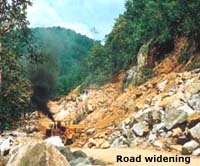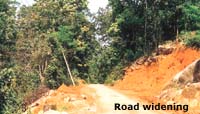
30th April 2000
News/Comment|
Editorial/Opinion| Business| Sports|
Sports Plus| Mirror Magazine

Kukule Ganga power project rushes through a conservation area destroying flora and fauna
Dam the river,damn the forest
By Tharuka Dissanaike
 The
nondescript sign that warned of 'road widening ahead' gave little indication
of the magnitude of work. Steam- rollers flattening freshly piled earth,
lorries transporting rock and rubble, workmen drilling into the mountainside
to place dynamite and huge earth-movers pushing the blasted rock away from
the road.
The
nondescript sign that warned of 'road widening ahead' gave little indication
of the magnitude of work. Steam- rollers flattening freshly piled earth,
lorries transporting rock and rubble, workmen drilling into the mountainside
to place dynamite and huge earth-movers pushing the blasted rock away from
the road.
A rickety stretch of road from Badureliya, past a two-shop town called Atweltota to Kukulegama is being widened and carpeted to carry heavy equipment to the country's latest hydro-electric project.
The tragedy of this road- widening is that it has already destroyed a large extent of forest cover. The widening operation is now just a few hundred metres short of the rich rainforests of the Warathalgoda Reserve. Widening work continues beyond the reserve area as well.
Like a bleeding wound, the raw gashes on the mountainsides shed tons of blasted rock and earth. This rubble is then indiscriminately pushed over the side of the road, down the slope, into the forest and the crystal water stream running below.
The impact of dynamite has caused adult trees to topple down the slopes below the road, like reeds caught in a storm. Rocks have crashed into the bubbling rainforest streams that flow lower down. Earth, tons and tons of it, has been pushed down the road, covering the sloping forest. The impact of heavy dynamiting have frightened off the wildlife and birds and squirrels fall dead from the trees at large blasts.
The Kukule Ganga hydro-electric project may well be Sri Lanka's final large-scale hydropower project, considering that Upper Kotmale has been embroiled in a legal wrangle for the past six years.
The 70 MW power project nestles in the Kalawana hills bordering Kalutara and Ratnapura districts. Being a run-of-the river power project, the Kukule Ganga hydro avoids many of the environmental problems that concern large dam building.
 In
its Environmental Impact Assessment (EIA) report, the project proponent,
being the Ceylon Electricity Board proposed the development of another
road, which leads off Badureliya town across Maskeliya.
In
its Environmental Impact Assessment (EIA) report, the project proponent,
being the Ceylon Electricity Board proposed the development of another
road, which leads off Badureliya town across Maskeliya.
But the equipment needed for the small weir could not be transported on this road. Hence, they needed to widen and strengthen the existing road between Badureliya and Kukulegama, where the new road then turns left into the project area, strictly barred for visitors, and the rickety old road continues to Kalawana and finally to Tiruwanaketiya and Ratnapura.
Villagers, many of them happy that the neglected stretch of road is being developed, said that it would be better if the widening continued up to Kalawana, so that the local populace could at least benefit substantially from the damage the project has wrought.
"In the EIA prepared in 1996, it is never mentioned that this roadway will be subjected to such massive clearing and widening," said Hemantha Withanage, Executive Director, Environment Foundation Limited. "The EIA does not mention this road access at all."
Warathalgoda was identified as an important conservation area in 1992 for its thick tree cover and suspected prehistoric caves. The reserve encompasses a high culvert of the British period known locally as the Ahas Bokkuwa and a Saman devale. By the side of the road is a huge Duna tree, said to be the largest tree on a roadside anywhere in Sri Lanka. Under the Forestry Master Plan it is listed as a Proposed Forest Reserve, but for all legal purposes it is counted as a protected area. The forest reserve has many indigenous plants, including some exotic orchids found only in this locality.
According to the National Environmental Act no. 47 of 1980 amended in 1988, clearing of a land area exceeding one hectare in a forest reserve has to be qualified by an EIA. But this requirement has not yet been met.
The Central Environmental Authority is supposed to monitor all large projects to see that they stick to the conditions set out by the approving agency. "But all our complaints to the CEA have fallen on deaf ears. They do not even have a monitoring committee to watch this project. We know that even bigger environmental damage is happening at the project site. Since the public cannot visit the area, an official monitoring committee should have been appointed," Mr. Withange said.
"To my knowledge they have not cleared more than a hectare of forest in the reserve," said Additional Conservator of Forests, Sarath Fernando. "They cannot start clearing beyond the Saman devale without an EIA."
But the fact is that the Road Construction and Development Corporation (RCDC) has already cleared part of the forest area and widened the road up to the devale and beyond the reserve.
Having already spent millions on the widening, it is unlikely that the CEB or the RCDC would abandon the road at this stage if the EIA finds it detrimental to the forest.








![]()
Front Page| News/Comment| Editorial/Opinion| Plus| Business| Sports| Sports Plus| Mirror Magazine
Please send your comments and suggestions on this web site to

